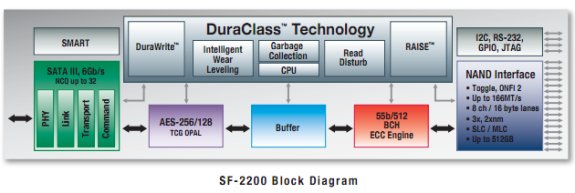
Posted on Thursday, February 24 2011 @ 19:16 CET by Thomas De Maesschalck
SandForce officially introduced its next-gen SF-2000 series solid state disk controllers. These new chips are designed to work with 2xnm and 3xnm class SLC/MLC NAND flash memory and promise to deliver data transfer speeds of up to 500MB/s.
MILPITAS, CA. – February 24, 2011 – SandForce® Inc., the pioneer of SSD (Solid State Drive) Processors
that enable standard NAND flash deployment in enterprise, client, and industrial computing
applications, today announced the much anticipated availability of its second-generation SF-2200 and
SF-2100 SSD Processors optimized for SSDs deployed in client computing applications. The SF-2200
processors feature a 6 Gigabit-per-second (Gb/s) SATA host interface, an unprecedented sustained
sequential read/write performance of up to 500 Megabytes per second (MB/s), and award-winning
DuraClass™ Technology. The SF-2100 processors feature a 3 Gb/s SATA host interface, read/write
performance up to 250 MB/s, and the same powerful DuraClass Technology. In addition to leading-edge
performance, the SF-2200 and SF-2100 Client products support state-of-the-art, high-speed ONFi2 and
Toggle flash interfaces in single-level & multi-level cell (SLC & MLC) NAND flash families from all major
suppliers.
"With high profile products now incorporating SSDs as standard storage media and most other system
vendors offering them as options, the market for client SSD applications is poised for growth as SSD
prices decline,” said Joseph Unsworth, Research Director, NAND Flash & SSD at Gartner. “SSD controllers
that can deliver superior performance and reliability without the dependence on DRAM will have a
compelling value proposition across a wide range of client applications.”
The SF-2200 and SF-2100 Client SSD Processors address the needs of cost-sensitive client storage
markets with many inherent enterprise-class features. These devices feature the highly sought-after
SandForce DuraClass Technology including RAISE™ and patented and patent-pending DuraWrite™
features to deliver the ultimate in performance, endurance, reliability, and power management.
Additionally, SF-2200 and SF-2100 Client SSD Processors feature:
• Support for advanced 30nm- and 20nm-class NAND flash from all leading flash vendors with
Asynch/ONFi1/ONFi2/Toggle interfaces with data transfer rates up to 166 Mega Transfers per
second
• Trusted Computing Group (TCG) OPAL security with 256-bit AES encryption and automatic, line-
rate double encryption with a drive-level password
• Advanced ECC engine correcting up to 55 bits per 512-byte sector to assure high data integrity and support for future generations of flash memory
• Power and performance optimization and tuning features to maximize mobile battery life
• Single-chip “DRAM-less” solution enabling highly compact and flexible designs
“As with our first-generation product, the new SF-2200 and SF-2100 Client SSD Processors break new
ground in terms of reliability, performance, and affordability by optimizing access to the most advanced
NAND flash technologies,” said Michael Raam, President and CEO for SandForce. “Manufacturers
building client SSDs can now introduce even higher performance products that further optimize the
computing user experience and enhance overall productivity which will continue to accelerate
mainstream laptop and PC market adoption of SSDs.”
Live SF-2200 and SF-2100 Product Demonstrations at CeBit
SSD manufacturers and system OEMs will demonstrate their SandForce Driven™ SF-2200 and SF-2100
products at the CeBit show in Hanover, Germany, on March 1-5, 2011. Be sure to look for the various
online product reviews that will follow those demonstrations.


